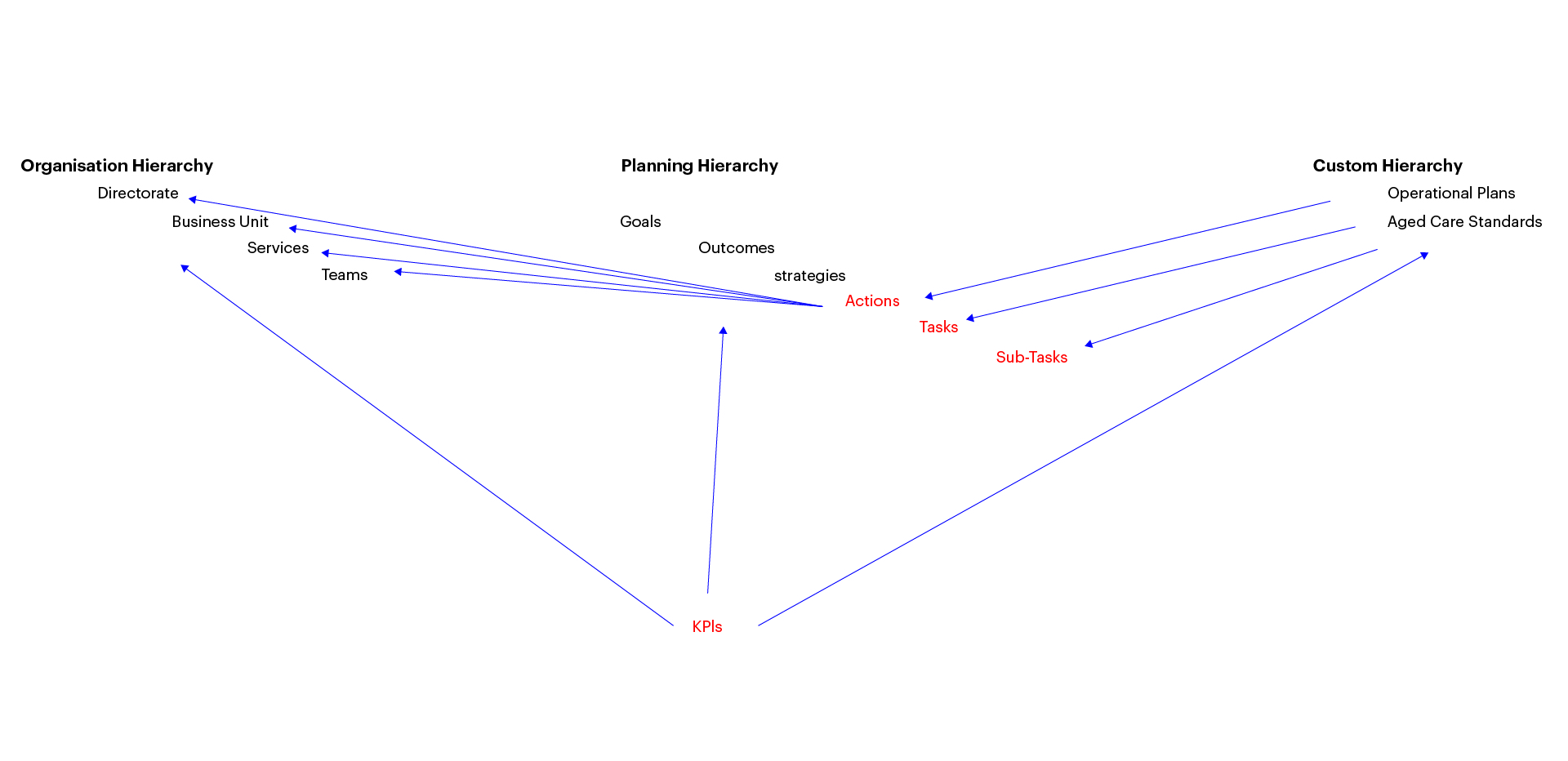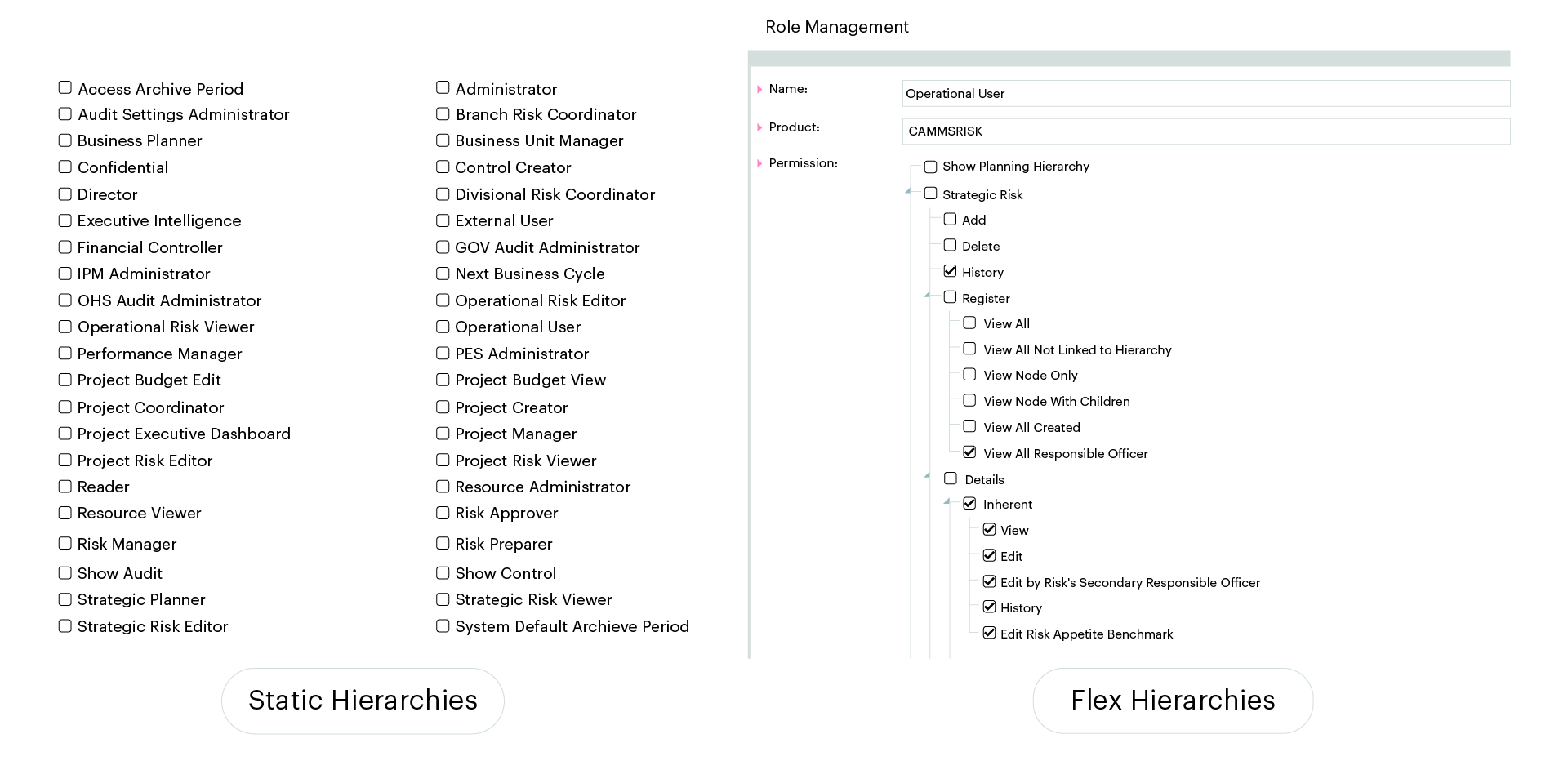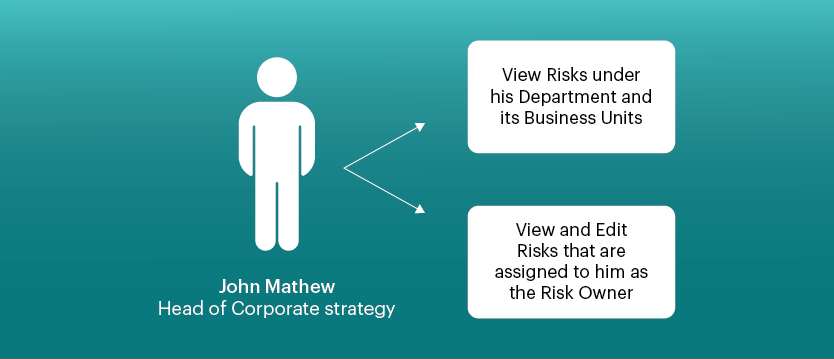Understanding Flex Hierarchies
Flex Hierarchies represent a dynamic and adaptable approach to structuring hierarchies within the Camms application, particularly suited for larger organisations or those with complex reporting and security needs.
The static organisation hierarchy, limited to three levels (Directorate, Business Unit, Service Profile), can be restricting for medium and large organisations. Introducing the flexible hierarchy allows unlimited levels, making it ideal for organisations that require a more extensive structure. Typically, a medium to large organisation’s flexible hierarchy may consist of 4-5 levels, extending down to team or program levels.
Moreover, beyond the organisation hierarchy, custom hierarchies can be set up to meet specific reporting requirements. Standard dashboards and reports support custom hierarchy filtration, enabling organisations to focus on specific aspects like ‘information security standards’ with ease. This level of customisation enhances data insights and reporting precision, driving organisational efficiency and informed decision-making.
Exploring the Purpose Behind Each Type of Hierarchy
Within the Camms application, three standard types of hierarchies are available, each serving distinct purposes:
Organisation Hierarchy: This type of hierarchy represents the overall organisational structure, extending from departments to business units and beyond. It provides a clear overview of the organisational layout and reporting lines.
Planning Hierarchy: The planning hierarchy is designed to support an organisation’s strategic planning process. It encompasses goals, objectives, initiatives, and tasks, facilitating the alignment of strategic objectives with actionable tasks.
Custom Hierarchy: With the custom hierarchy feature, organisations can define hierarchies tailored to their specific reporting and information management needs. Examples of custom hierarchies include Information Security standards, Aged Care standards, and Risk Tiers. This level of customisation allows for more targeted reporting and streamlined data management.

Static Hierarchies vs. Flex Hierarchies: Which is Right for You?
Static Hierarchies have their place in small organisations with simpler security and reporting requirements. However, when an organisation outgrows the limitations of a three-level hierarchy structure, Flex Hierarchies becomes the preferred choice. In terms of hierarchy setup, Flex Hierarchies allow for an unlimited number of levels, while static hierarchies are rigidly limited to three levels. Moreover, Flex Hierarchies support custom hierarchies, enabling organisations to tailor the structure to their unique needs. In terms of permissions, Flex Hierarchies offer configurable and bespoke permission structures, while static hierarchies have pre-defined, inflexible permission sets. The flexibility of Flex Hierarchies makes them the ideal solution for larger organisations or those with complex security and reporting requirements.
Static Hierarchy: The organisation hierarchy can only have three levels. This means that there can only be three levels of reporting in the organisation. For example, there could be a CEO, a few directors, and then a few managers.
Permissions: There are predefined roles in the organisation. This means that users are assigned to roles, and each role has a set of permissions. For example, the CEO might have the permission to create new users, while managers might only have the permission to edit existing users.
Flexible Hierarchy: The organisation hierarchy can extend to any number of levels. This means that there can be any number of levels of reporting in the organisation. For example, there could be a CEO, a few directors, then a number of managers, and then a number of team leaders, and so on.
Permissions: The organisation can cater to complex security requirements. This means that the organisation can create custom permissions for users, based on their role and responsibilities. For example, the CEO might have the permission to create new users, edit existing users, and delete users, while managers might only have the permission to edit existing users.
This infographic provides a visualisation of Static Hierarchies vs. Flex Hierarchies

Benefits of Flex Hierarchies
Enhanced Structure and Reporting
Flex Hierarchies allow organisations to create custom hierarchies to meet specific reporting requirements. This means that information can be structured and organised in a way that aligns with the organisation’s unique needs. For example, a company could create a custom hierarchy for information security standards and use standard dashboards to report on risks associated with these standards.
Fine-Grained Permissions
Flex Hierarchies offer granular control over access and permissions, allowing organisations to configure bespoke permissions based on specific requirements. Within the Camms application, each product has its permission tree, and multiple roles can be set up using the nodes within the tree. This flexibility ensures users have access to the right information while upholding data security. Notably, users can also filter, and view reports/dashboards based on assigned permissions and linked departments, enhancing the relevance and efficiency of data presentation.
Streamlined Communication Channels
In complex organisations with diverse departments and business units, communication can often become fragmented. Flex Hierarchies offer a solution by enabling clear and efficient communication channels across different levels and teams. By defining hierarchies that align with the organisational structure, information and updates can flow seamlessly, ensuring that relevant stakeholders are involved in decision-making processes. This streamlined communication promotes collaboration, reduces redundancy, and enhances overall efficiency.
Cross-Functional Collaboration
Flex Hierarchies encourage cross-functional collaboration by breaking down silos and promoting a more integrated approach. In traditional static hierarchies, collaboration is often limited to within specific departments or levels. However, Flex Hierarchies provide the flexibility to establish collaboration across different levels, departments, or even geographies. This encourages diverse teams to work together, share knowledge, and leverage collective expertise. As a result, organisations can foster innovation, solve complex problems, and drive continuous improvement.
Agile Decision-Making
With the ability to configure bespoke permissions and assign roles based on specific needs, Flex Hierarchies empower organisations to make agile and informed decisions. Decision-makers can access the relevant data and reports in real-time, enabling them to respond quickly to emerging opportunities or risks. By aligning the hierarchy structure with decision-making processes, organisations can ensure that the right individuals have access to critical information, enabling faster and more accurate decision-making. This agility is especially valuable in dynamic industries where swift responses can make a significant difference.
Hierarchical Insights for Strategy Alignment
Flex Hierarchies support strategic alignment within organisations by providing valuable insights at different hierarchical levels. Decision-makers can access reports and dashboards that highlight performance metrics, risks, and opportunities across various levels of the hierarchy. This hierarchical view allows organisations to identify patterns, trends, and areas for improvement. With these insights, leadership can align strategic initiatives, allocate resources effectively, and ensure that goals cascade down to operational levels.
Empowerment and Ownership
Flex Hierarchies empower individuals at different levels of the organisation by giving them a sense of ownership and accountability. By granting appropriate permissions and access based on roles and responsibilities, employees feel empowered to take ownership of their work and make meaningful contributions. This fosters a culture of trust, engagement, and collaboration, where individuals are encouraged to share ideas, innovate, and drive positive change within their respective areas of responsibility.
Real-World Scenarios and Examples
Head of Department
Consider a scenario where John is the head of the corporate strategy department in an organisation. John should have access to view all risks within his department and its associated business units. With Flex Hierarchies, a role called “Head of Department” can be created and assigned to John. This role would grant him access to view risks linked to the corporate strategy node and its child nodes. John would also be able to view and edit risks assigned to him as the risk owner, providing him with the necessary control and visibility.

Enhancing Service Delivery in Local Councils
Flex Hierarchies offer local councils the opportunity to enhance service delivery and community engagement. By customising hierarchies to reflect the community structure, councils can facilitate targeted communication and consultation. This enables efficient resource allocation and optimised service delivery. Streamlined reporting and compliance are achieved by linking records to specific nodes, ensuring accurate reporting and informed decision-making. Transparent governance is fostered through assigned roles and permissions, promoting accountability and community involvement in decision-making processes. Flex Hierarchies also empower local councils to monitor performance and allocate resources effectively, ultimately improving service delivery and strengthening community engagement.
Custom Reporting Requirements
Organisations often have specific reporting needs beyond the standard hierarchy structure. Flex Hierarchies can address these requirements by allowing the creation of custom hierarchies. For instance, a company may want to analyse risks based on different standards, such as information security standards or aged care standards. By defining a custom hierarchy for these standards and linking risks accordingly, organisations can generate tailored reports and gain deeper insights into their risk landscape.
Scaling for Future Growth
Flex Hierarchies provide a scalable solution that can adapt to organisational growth and changing needs. As organisations expand, they can easily add new levels or nodes to their hierarchies. For example, if additional levels like programs or teams need to be included, administrators can configure them using the Flex Hierarchy feature. This flexibility ensures that the hierarchy structure remains aligned with the evolving organisational structure.
A New Way to Organise for Agility and Success
Flex Hierarchies revolutionise the way organisations structure and manage hierarchies within the Camms application. By providing a flexible and adaptable approach, Flex Hierarchies enable organisations to meet their specific reporting, security, and access needs. The ability to configure custom hierarchies, define granular permissions, and scale for future growth empowers organisations to unlock their full potential for organisational agility.
If you’re looking to maximise the benefits of the Camms application using Flex Hierarchies, don’t hesitate to book a virtual consultation session with the product consultants at Camms.College. Embrace Flex Hierarchies and take your organisation’s agility to new heights.
To learn more about how Flex Hierarchies can help your organisation become more agile, join our on demand webinar, Unleashing the Power of Flex Hierarchies for Organisational Agility.












